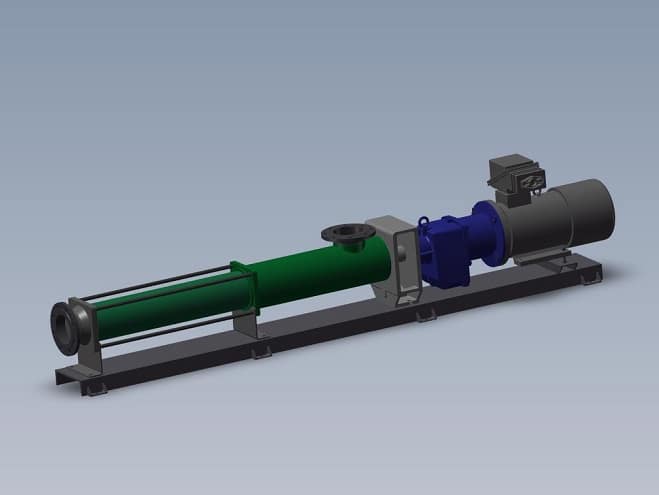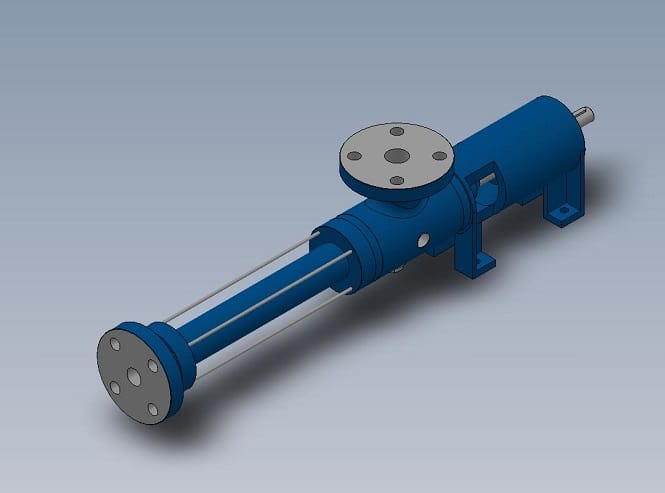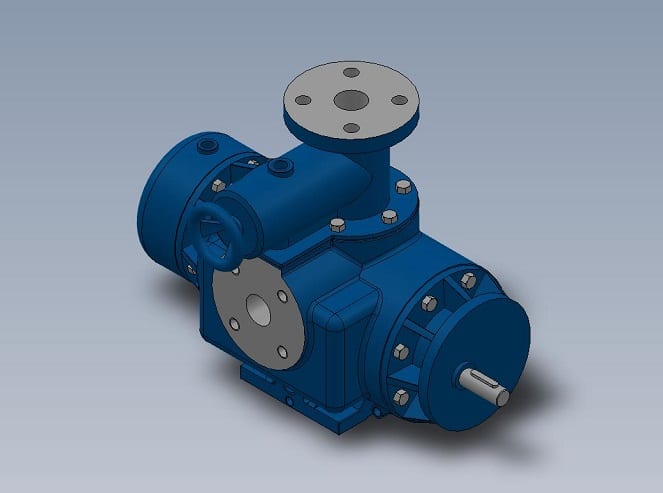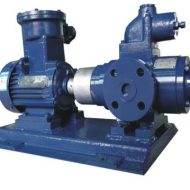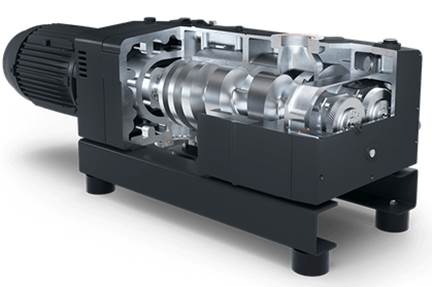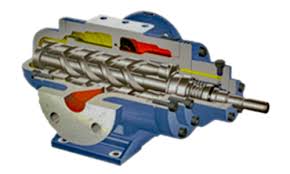Screw Pump
Introduction
A screw pump is a type of positive displacement pump. This pump is also known as a water screw pump. As the name suggests this pump uses a screw to transport fluids along its screw axis. The pump screws interlock to create pressure that moves the fluid in the system. The screws are in mesh with each other. When a fluid is to be pumped, it enters the pump via a suction valve and linearly flows to the discharge side along with interlocking screws. There is a small space between the pump cavity and screw and this increases the pressure of the fluid as the fluid passes through the pump. Screw pump manufacturers make the pump for use in different industries like shipping, power generation, terminals, chemical processing, and pipelines, production of oil and gas, and refineries.
REQUEST A QUOTE FOR MORE DETAILS
What is a screw pump?
The screw pump is very friendly as it rarely needs maintenance due to its few number of rotating parts. This pump helps when one intends to pump a fixed volume of liquids of various viscosities, volume, and pressure ranges. This type of pump is reliable and easy to operate. Screw pump manufacturers make the pump design easy for maintenance. This type of pump gets power from a prime mover which could be an internal combustion (IC) engine or induction electric motor. The screw pump housing has discharge and suction ends. A suction valve is placed at the base of the pump and a discharge valve is placed at the top. There is also a check valve mounted at the discharge end to prevent fluid from flowing backward.
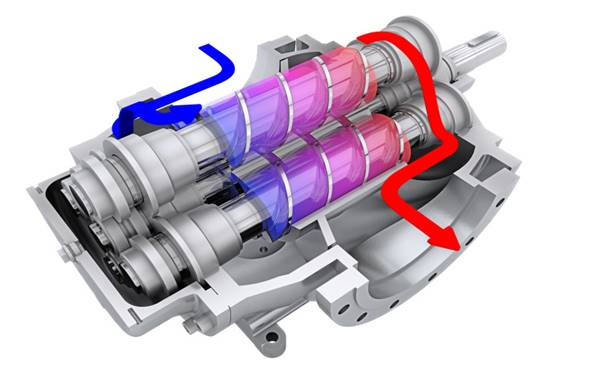
Figure: Screw pump.
How does a screw pump work?
As mentioned earlier a screw pump is a positive displacement pump. This type of pump is driven using two screws in counter-rotation. When the screw pump starts working, the power is transmitted from the prime mover using the driver screw. The driver screw is connected to the driving shaft responsible for driving the driver screw. As soon as the driving screw starts spinning, the driven screw also spins as both are in mesh with each other. When the screws move, they result in a partial vacuum at the inlet side of the pump. Because of this vacuum, the fluid is sucked into the pump from the suction valve. As the fluid gets into the pump, it gets trapped between screws’ gap. The trapped fluid move as the screws keep rotating. As the screws move, the amount of the trapped fluid decreases, and the fluid pressure increases. When the fluid pressure increases to the desired pressure level it exits from the outlet valve and flows to the required destination.
When a screw pump is working on viscous fluid such as oils, the surface of the screw becomes lubricated as the fluid pumps such that there is a small or no gap between the rotating screws.
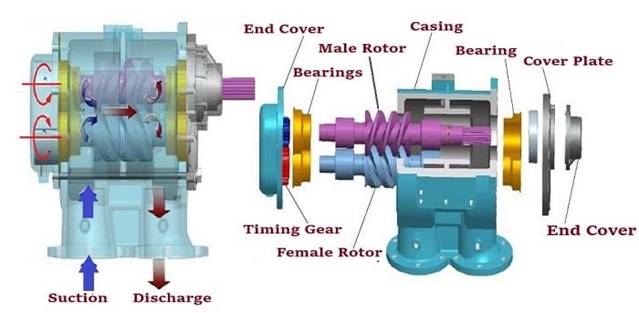
Figure: Working of a screw pump.
Components of a screw pump
A screw pump consists of several components. The most common are driver screw, driven screw, timing gear, pressure relief valve, bearings, inlet, and outlet ports, and driving haft.
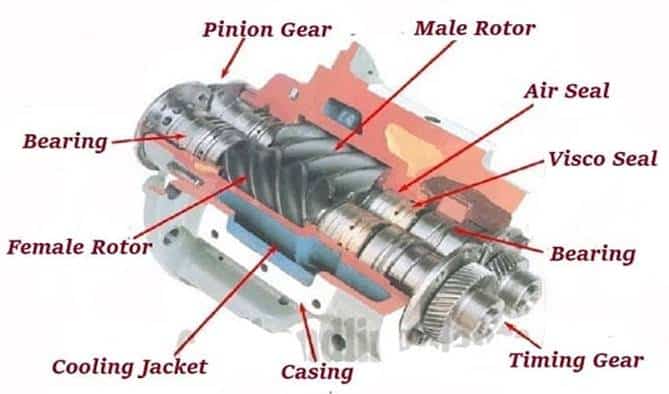
Figure: Components of screw pumps.
Driver screw
This is one of the rotating components of a screw pump. This part helps to connect the motor and the driving shaft. It helps to pump fluid at a consistent flow rate. One side of the driver screw connects to the timing gear while the other side connects to the driving shaft. The driver screw is driven by the prime mover shaft. With power from the prime mover, the driver screw rotates the driven screw. Both driver screw and driven screw are in mesh. The driver screw is made of a very strong metallic material such as high tensile steel. The main function of the driver screw is to rotate the driven screw using a timing gear.
Driven screw
The driven screw is also made of the same strong material as the driver screw such as high tensile steel. This component rotates along its axis because of movement enhanced by the timing gear. The driven screw and driver screw rotate in opposite directions. The driven screw has a consistent clearance area. This clearance area helps to catch fluid in the tight clearance. When the driven and driver screw move simultaneously, the fluid volume decreases and moves to the outlet port. Through this movement, the fluid pressure increases. As such, the fluid discharges via the discharge port.
Timing gear
This gear drives the driven screw. They work in a way that prevents metal-to-metal contact between male and female rotor assembly. This helps to connect the driver screw and driven screw. The timing gear receives power through the driver screw which is then transmitted to the driven screw. As such, it drives the driven screw.
Inlet and outlet ports
There are different inlet and outlet ports in a screw pump. The inlet port is used to suck fluid into the pump. The outlet port is used to discharge fluid to the piping system. Screw pump manufacturers make the pumps such that there is sufficient fluid medium when pumping stops. This helps to deliver the initial fluid for the pump. Hence, even when the suction tube is dry or empty, the pump will not dry in a short time.
Pressure relief valve
Screw pumps are under the category positive displacement pumps. These pumps can create pressure even if the outlet is closed. As such, this results in pressure build-up that can lead to damage of internal parts of the pump or injury to the pump operator. As such, screw pump manufacturers design the pump with a pressure relief valve that helps to protect the operator, the pump, and other connected machines. The relief valve returns the extra pressure to the inlet. Another alternative to neutralize extra pressure is by recirculating outlet fluid.
Bearings
When the screw pump mounted vertically is running, the upper bearings experience more loads and forces in axial and radial directions. As such, the lower bearings experience very low stress. The lower bearing is meant for sustaining pump alignment parts. For screw pumps installed in a parallel direction, sliding and roller bearings experience very low loads. This happens because the resultant axial and radial loads are opposite to each other and thus they cancel out.
Driving shaft
This is a shaft that is used to transmit power from the prime mover to the pump assembly. This is achieved by using appropriate mechanical couplings to ascertain mechanical strength between the connected shafts. In most cases, the driving shaft is the main pump component as it runs from side to side to secure the operation of the driver screw. The pump of this construction has the driving shaft securing bearing fitted in the axial direction. As such, it is very important to align the driving shaft perfectly to help the pump have a long life span.
Screw pump Types
Single screw pump
Single screw pumps work by employing the positive displacement principle. This pump is made up of a single spiral rotor and double spiral stator. These pumps are reversible. When the pump rotor moves in the stator it forms cavities. As such, the fluid moves along the generated cavity because of positive displacement action after which it gets discharged from the pump via the discharge port. These pumps are also known as worm pumps, progressive cavity pumps, or PC pumps. Single screw pumps are suitable for pumping fluids that need steady and non-pulsating flow. Single screw pumps are best known for their superb suction capacity. They are used in several industries such as sewage, oil and gas, shipping, paint, chemicals, papers, ceramics among others. Single screw pumps can effectively work on abrasive or non-abrasive media with or without solid particles such as sludge, bilge water sewage among others. Single screw pumps are cheaper. Most importantly, single screw pumps do not clog.
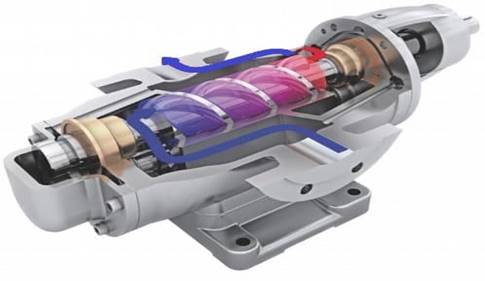
Figure: Single screw pump.
Single screw pump
Single screw pumps work by employing the positive displacement principle. This pump is made up of a single spiral rotor and double spiral stator. These pumps are reversible. When the pump rotor moves in the stator it forms cavities. As such, the fluid moves along the generated cavity because of positive displacement action after which it gets discharged from the pump via the discharge port. These pumps are also known as worm pumps, progressive cavity pumps, or PC pumps. Single screw pumps are suitable for pumping fluids that need steady and non-pulsating flow. Single screw pumps are best known for their superb suction capacity. They are used in several industries such as sewage, oil and gas, shipping, paint, chemicals, papers, ceramics among others. Single screw pumps can effectively work on abrasive or non-abrasive media with or without solid particles such as sludge, bilge water sewage among others. Single screw pumps are cheaper. Most importantly, single screw pumps do not clog.
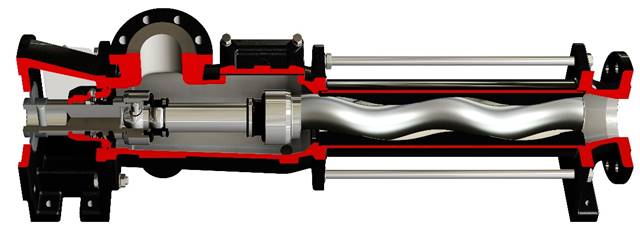
Figure: Eccentric screw pump.
Twin-screw pump
A twin-screw pump is also known as a two-screw pump or double screw pump. The name is because this pump has two screws. A twin-screw pump is a versatile pump that is meant for heavy-duty operations like the transfer of heavy oil. Twin-screw pumps are self-priming. This type of screw pump has drive connected to prime mover and it contains a gear used to turn the next screw. Twin-screw pumps are used in different industries such as food, shipping, and energy petrochemical among others. This pump has superb performance due to its properties such as:
- Ability to run dry.
- Low liquid sheer.
- It can operate at variable speeds.
- It needs a low net positive suction head.
- It can tolerate contamination.
- It can handle large amounts of fluids and fluids of high viscosity.
- It is highly reliable.

Figure: Twin-screw pump.
Triple screw pump
A triple screw pump is also known as a three-screw pump. As the name suggests, this pump has three screws and a prime mover which is either an electric motor or IC engine. This type of screw pump is one of the most common screw pumps used in power generation applications. It has a single rotor made of hardened steel. The rotor dies the pumping task together with two idle rotors made of cast iron or hardened steel. The rotors work on a thin fluid film in the pump liner that serves as a large journal bearing to enhance support and protect against metal-to-metal contact. Also, triple screw pumps have an internal balance line that helps to balance the rotors thus nullifying axial forces and the need for thrust bearings. This pump needs a single bearing to position rotors and a single seal depending on suction pressure.
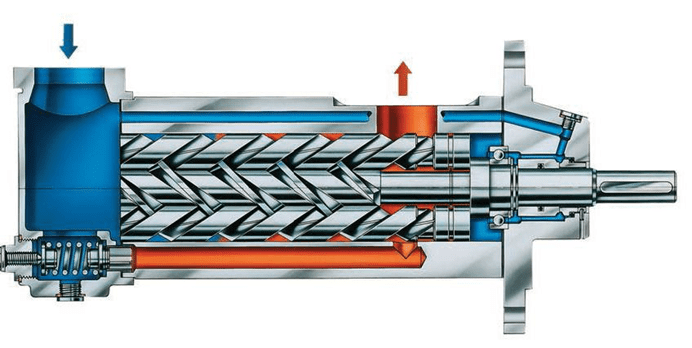
Figure: Triple-screw pump.
Screw vacuum pump
The screw vacuum pump is a type of rotary screw pump used to create a vacuum. The screw vacuum pump consists of two mating rotors. The two rotors rotate in opposite directions. The action of rotation is responsible for moving trapped air molecules along the screws. The trapped air moves along the screw and finally, it becomes compressed, and then it discharges on the opposite side. These pumps can be dry or oil-sealed. The dry vacuum screw pump does not need lubrication/oil chamber. They are free from oil emissions and are cooled by air. The dry vacuum screw pumps can create a higher vacuum compared to the oil-sealed vacuum screw pump. The oil-sealed pump uses oil for cooling, sealing, and lubrication. The oil-sealed vacuum screw pump is suitable for rough applications that do not have clean vacuum requirements. Applications of vacuum screw pump packaging, woodworking, drying, and cleaning among others.

Figure: Vacuum screw pump
Advantages of screw pump
- Screw pumps manufacturers make the pumps such that they can run dry.
- Screw pumps are made of compact structure enhancing their strength.
- Screw pumps move fluids in the axial direction without causing turbulence. This helps to reduce bubbles formed due to viscous fluids.
- Screw pumps are easy to do repair and maintenance.
- Screw pumps can be used for all types of fluids.
- These pumps rarely make noise while in operation.
- Screw pumps transport non-pulsating and consistent flow of fluids.
- Screw pumps have self-priming capabilities.
- They are robust in their construction making them strong.
- They are reliable as they rarely fail while in use.
- They transport fluids at a very high speed.
- Screw pumps have a high tolerance against water vapors and dust particles.
- Screw pumps have frictionless rotation.
- They are known to have high efficiency.
- They can pump highly viscous fluids without losing the fluid flow.
Disadvantages of screw pump
- Installation of screw pumps is quite expensive for small industries.
- It needs the help of gas ballast to transport light gases.
- The performance of screw pumps is sensitive to changes in viscosity.
- Long pumping elements are required for high-pressure pumping.
Screw pump application
- Screw pumps are used to supply oil in hydraulic and lubrication machines.
- Screw pumps are used in gas and oil, manufacturing, and mining industries.
- Screw pumps are used in food, paint, chemicals, paper, and ceramics industries.
- Screw pumps are used to create a vacuum for different industries such as food, paper, and printing among others.
- Screw pumps are used to pump heavy and viscous fluids.
Screw pump troubleshooting
Incorrect rotation direction on screw pump
- This could be due to a phase connection error. In the case of a three-phase motor, invert the two wires connecting the electrical phases.
The delivery flow rate is very low
- The delivery line valves are not well opened. Open the valves fully and restart the pump.
- Foreign bodies clogging the filter. Check the filter to remove foreign bodies. Check the plant.
- The calibrated pressure valve value is too low. In this case, loosen the adjusting screw to a point it can turn manually and restart the pump for some minutes without pressure. Next, tighten the adjusting screw to a point where the calibration value is needed.
Screw pump pressure is too low
- There is leakage in the pipe. Check the pipes for leakages.
- Very low outlet pressure. In this case, replace the pump with another pump with a higher flow rate.
- The highest pressure valve value calibrated is very low. In this case, loosen the adjusting screw to a point it can turn manually and restart the pump for some minutes without pressure. Next, tighten the adjusting screw to a point where the calibration value is needed.
Difficult starting motor
- The system required pressure is too high. In this case, check the plant for the pressure requirements.
- Too low motor calibration relay. Improve threshold for the relay intervention.
- The motor being used is not suitable for the load. Replace this motor with another motor of a higher power rating.
- The oil used is too cold. Start the pump without pressure to a point when the oil attains its normal temperature.
Summary
A screw pump is a pump under the category of positive displacement pumps. It works with one or more screws. Screw pumps work by rotating two screws in opposite directions. It gets power from either an electric motor or an IC engine. A driver screw is used to transmit power from the prime mover to the pump. When the pump screws rotate, a vacuum is created at the inlet of the pump. This vacuum makes the fluid to be sucked by the pump via the suction valve and it keeps flowing through the pump to the discharge section.
There are several types of screw pumps such as single screw pump, twin-screw pump, eccentric screw pump, triple screw pump, and vacuum screw pump. These pumps have superb characteristics which makes them suitable for use in many industries such as oil and gas, chemicals, food, paint, paper, ceramics, among others. Screw pumps are known to have several advantages relative to other pumps such as being easy to do maintenance, being self-priming, reliable, compact structure, high efficiency, and low pulsations. However, screw pumps are expensive when installed for small industries.

